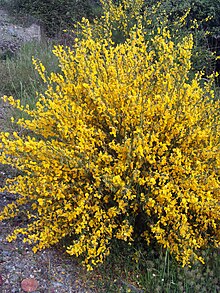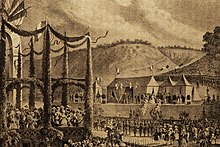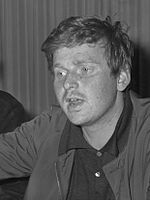Golden Bremm
Goldene Bremm ( French fluctuating usage: Brème d'Or , Brême d'Or , Breme d'Or ) is an area name in the German-French border area between the city of Saarbrücken and the towns of Stiring-Wendel and Spichern, which are part of the Stiring-Wendel canton . The Saarland borders on the Moselle department in the Grand Est region . Important road connections cross the German-French border here. The area that was fiercely contested in the Franco-Prussian War of 1870/71, which was also the battlefield and location of the Gestapo camp in Neue Bremm during World War II , is now a memorial and meeting place within the Saar-Lor-Lux Euroregion .
etymology
The "Alte Bremm" is about 400 m west of the border on French territory, the "Goldene Bremm" close to the border and the "Neue Bremm" about 1000 m east of the border. The Goldene Bremm lies on the French side in the district of Spichern, while the section in the district of Saarbrücken is called Neue Bremm ; popularly this is not clearly differentiated. The motorway exit on the German side is also called Goldene Bremm . Next is the Golden Bremm the name of restaurants. In the 19th century the border between Preussisch-Kohlhof and Bayerisch-Kohlhof was also called this.
Until about 1820 the place was called the Zollstock . The name Goldene Bremm became common after Claude Mouton had built the inn "Zur Goldenen Bremm" - "Auberge de la Brème d'Or" on the border. Bremm is the name of the golden yellow flowering broom species that is widespread in the region. In the Lorraine-Rhenish Franconian dialect, this gorse is called Bremme (cf. Middle High German brimme , Dutch brem or English broom for “gorse”. The word broom also means “broom” in English, as the “broom” gorse used to sweep up has been).
Infrastructure
Here the former Kaiserstraße , built in 1810/11, crossed the German-French border, followed by the N 3 - B 41 and Europastraße 50 with the A 320 - A 6 motorways built in 1968/69 .
Before the Schengen Agreement , border formalities were carried out at the federal road and at the Goldene Bremm motorway crossing ; Motorway petrol station and motorway service area are still available even after passport and customs control has been discontinued. For France, too, this was and is one of the most important crossing points in German-French border traffic.
A conference hotel of the Novotel chain on the German side also bore the name Goldene Bremm ; However, this name has not been preserved in today's Mercure Hotel.
Neue Bremm is also the name of a restaurant on the German side of Metzer Strasse.
Neue Bremm Memorial
The centerpiece of the memorial, designed by the French architect André Sive in 1947 on the site of the former Neue Bremm camp on Metzer Strasse, is a 30 m high steel obelisk. Since 1998 discussions have arisen about a redesign of the memorial, which has been degenerated due to inadequate maintenance and construction. One of the 136 ideas for renewal of this memorial alludes to the etymology of the “Goldene Bremm” area, a steel plate by Gertrud Riethmüller with the words Will nicht scarben , which emerged from a 1999 performance entitled Gorse light - streaks in the face . Before the eyes of the passers-by in the pedestrian underpass in front of the obelisk, the artist had burned these words into the plate with a welding torch. This steel plate hangs today on the south side of the former men's camp.
On May 8, 2004, the memorial, rebuilt according to plans by the Berlin architects Nils Ballhausen and Roland Poppensieker , was reopened under the heading “Hotel of Remembrance”. At night, a 65 m long concrete wall bears the illuminated lettering "HOSTAL HOSTILE HOTEL HOSTAGE GOSTIN OSTILE HOSTEL HOSTIL HOST", which means so much in its etymological pun that a hostile place has become a hospitable place, alluding to that on the grounds of the Novotel Goldene Bremm (today Mercure Saarbrücken-Süd), which is exactly opposite the former women's camp and which is conceptually included in the idea. A reception area with documentation in German and French was created along the wall.
Events

When Princess Helene Luise Elisabeth of Mecklenburg-Schwerin crossed the border to her future kingdom on May 25, 1837 on her way to Fontainebleau to meet her fiancé, the heir to the French throne Duke Ferdinand von Orléans , she was given a splendid welcome. A gate of honor and a magnificent tent for 100 people awaited the princess, who had her breakfast at the Goldenen Bremm. The dishes had been brought from Paris. 24 young girls presented her with a crown and flowers. The representatives of the French and Prussian authorities assured each other of good neighbors. Troop marches and regimental music bid farewell to the princess from Prussia and greeted her in France. An incalculable crowd of two nations attended the spectacle. In addition to a detailed description of the reception, Ruppersberg also provides a pictorial representation.
Only 33 years later, at the beginning of the Franco-Prussian War, the Goldene Bremm was the scene of the bloody battle near Spichern on August 6, 1870. A war correspondent wrote:
“On the road from Saarbrücken to France, close to the border, already on French soil, there is a tavern called“ The Golden Brake ”. In times of peace it serves as a friendly retreat for the residents of the mutual border districts, and its location on the much-visited road to Forbach is a very advantageous one. But on August 6th, during the battle for Spichern, it was in the middle of the French battle position [...]. The headquarters of General Frossard had actually been located in the Golden Brake Inn since August 2nd . During the battle of the 6th, however, this military leader is said to have been in Forbach until the evening. "
On May 24, 1968, the then student leader Daniel Cohn-Bendit , who a few days earlier had been banned from living in France due to his leading role in the student protests in May 1968, tried to enter France at the Goldenen Bremm. He was accompanied by around 800 students who had come with him to the border after a teach-in at Saarland University and demonstrated there for his re-entry. A large number of riot police on the German side and members of the Republican Guard on the French side had sealed off the border. Even after negotiations with the sub-prefect in Forbach , Cohn-Bendit was refused entry. On the same day, however, he secretly crossed the Green Border and traveled to Paris.
On New Year's Eve 1992/93 the first Saarland-Lorraine neighborhood festival with fireworks, laser show and musical performances by Patricia Kaas took place on the Goldenen Bremm .
From 1994 to 2002 there was a comparable festival at the Goldenen Bremm every year in the German-French friendship month of May, in which traditionally the French theater and culture days Perspectives du Théâtre took place in Saarbrücken (these have been moved to June since 2006); the festival was organized alternately by the Saarland and the Lorraine region and attracted up to 30,000 visitors.
literature
- Joseph Allmang: Les Lieux-dits de Spicheren, Moselle. Die Spicherer Flurnamen , Augny 1969, p. 73, p. 115
Web links
- Neue Bremm Memorial ( Memento from October 9, 2007 in the Internet Archive )
- Saarland-Lorraine neighborhood festival
- Reception of the Duchess of Orleans on May 25, 1837 (based on Albert Ruppersberg: History of the City of Saarbrücken , Volume 2, reprint of the 2nd edition from 1914, p. 24)
supporting documents
- ^ Topographic map 1: 25,000, sheet 6707 Saarbrücken, 1958 edition
- ^ Joseph Allmang: Les Lieux-dits de Spicheren, Moselle. Die Spicherer Flurnamen , Augny 1969, p. 73, p. 115
- ↑ LothWB: Bremme , LothWB: Brimmen , PfWB: Brimme
- ↑ Lexer: brimme
- ^ Albert Ruppersberg : History of the City of Saarbrücken , Volume 2, reprint of the 2nd edition from 1914, pp. 23-26
- ^ Albert Ruppersberg: History of the City of Saarbrücken , Volume 2, reprint of the 2nd edition from 1914, p. 24
- ^ Illustrated war chronicle , memorial book to the Franco-German campaign of 1870-1871, Leipzig 1871, p. 91. Online
- ↑ The Forbach Spectacle. Water cannons, dogs and horses: Cohn-Bendit couldn't get through. Die Zeit , No. 22, May 31, 1968, accessed January 30, 2014 .
- ^ Heinrich Grittmann: My "May 68" (May 24th, 1968) in Saarbrücken. (No longer available online.) Archived from the original on February 2, 2014 ; accessed on January 30, 2014 . Info: The archive link was inserted automatically and has not yet been checked. Please check the original and archive link according to the instructions and then remove this notice.
Coordinates: 49 ° 12 ′ 30 ″ N , 6 ° 57 ′ 54 ″ E



